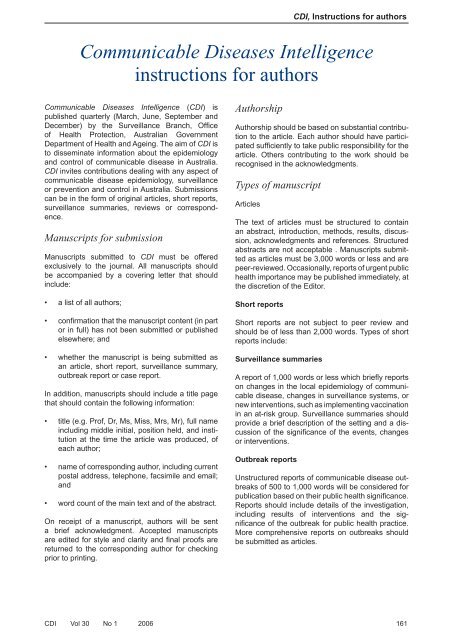PDF file - Department of Health and Ageing
PDF file - Department of Health and Ageing
PDF file - Department of Health and Ageing
You also want an ePaper? Increase the reach of your titles
YUMPU automatically turns print PDFs into web optimized ePapers that Google loves.
CDI, Instructions for authors<br />
Communicable Diseases Intelligence<br />
instructions for authors<br />
Communicable Diseases Intelligence (CDI) is<br />
published quarterly (March, June, September <strong>and</strong><br />
December) by the Surveillance Branch, Offi ce<br />
<strong>of</strong> <strong>Health</strong> Protection, Australian Government<br />
<strong>Department</strong> <strong>of</strong> <strong>Health</strong> <strong>and</strong> <strong>Ageing</strong>. The aim <strong>of</strong> CDI is<br />
to disseminate information about the epidemiology<br />
<strong>and</strong> control <strong>of</strong> communicable disease in Australia.<br />
CDI invites contributions dealing with any aspect <strong>of</strong><br />
communicable disease epidemiology, surveillance<br />
or prevention <strong>and</strong> control in Australia. Submissions<br />
can be in the form <strong>of</strong> original articles, short reports,<br />
surveillance summaries, reviews or correspondence.<br />
Manuscripts for submission<br />
Manuscripts submitted to CDI must be <strong>of</strong>fered<br />
exclusively to the journal. All manuscripts should<br />
be accompanied by a covering letter that should<br />
include:<br />
• a list <strong>of</strong> all authors;<br />
• confi rmation that the manuscript content (in part<br />
or in full) has not been submitted or published<br />
elsewhere; <strong>and</strong><br />
• whether the manuscript is being submitted as<br />
an article, short report, surveillance summary,<br />
outbreak report or case report.<br />
In addition, manuscripts should include a title page<br />
that should contain the following information:<br />
• title (e.g. Pr<strong>of</strong>, Dr, Ms, Miss, Mrs, Mr), full name<br />
including middle initial, position held, <strong>and</strong> institution<br />
at the time the article was produced, <strong>of</strong><br />
each author;<br />
• name <strong>of</strong> corresponding author, including current<br />
postal address, telephone, facsimile <strong>and</strong> email;<br />
<strong>and</strong><br />
• word count <strong>of</strong> the main text <strong>and</strong> <strong>of</strong> the abstract.<br />
On receipt <strong>of</strong> a manuscript, authors will be sent<br />
a brief acknowledgment. Accepted manuscripts<br />
are edited for style <strong>and</strong> clarity <strong>and</strong> fi nal pro<strong>of</strong>s are<br />
returned to the corresponding author for checking<br />
prior to printing.<br />
Authorship<br />
Authorship should be based on substantial contribution<br />
to the article. Each author should have participated<br />
suffi ciently to take public responsibility for the<br />
article. Others contributing to the work should be<br />
recognised in the acknowledgments.<br />
Types <strong>of</strong> manuscript<br />
Articles<br />
The text <strong>of</strong> articles must be structured to contain<br />
an abstract, introduction, methods, results, discussion,<br />
acknowledgments <strong>and</strong> references. Structured<br />
abstracts are not acceptable . Manuscripts submitted<br />
as articles must be 3,000 words or less <strong>and</strong> are<br />
peer-reviewed. Occasionally, reports <strong>of</strong> urgent public<br />
health importance may be published immediately, at<br />
the discretion <strong>of</strong> the Editor.<br />
Short reports<br />
Short reports are not subject to peer review <strong>and</strong><br />
should be <strong>of</strong> less than 2,000 words. Types <strong>of</strong> short<br />
reports include:<br />
Surveillance summaries<br />
A report <strong>of</strong> 1,000 words or less which briefly reports<br />
on changes in the local epidemiology <strong>of</strong> communicable<br />
disease, changes in surveillance systems, or<br />
new interventions, such as implementing vaccination<br />
in an at-risk group. Surveillance summaries should<br />
provide a brief description <strong>of</strong> the setting <strong>and</strong> a discussion<br />
<strong>of</strong> the signifi cance <strong>of</strong> the events, changes<br />
or interventions.<br />
Outbreak reports<br />
Unstructured reports <strong>of</strong> communicable disease outbreaks<br />
<strong>of</strong> 500 to 1,000 words will be considered for<br />
publication based on their public health signifi cance.<br />
Reports should include details <strong>of</strong> the investigation,<br />
including results <strong>of</strong> interventions <strong>and</strong> the signifi<br />
cance <strong>of</strong> the outbreak for public health practice.<br />
More comprehensive reports on outbreaks should<br />
be submitted as articles.<br />
CDI Vol 30 No 1 2006 161
















